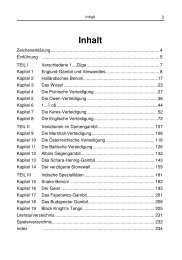Knight on the Left - Schachverlag Kania
Knight on the Left - Schachverlag Kania
Knight on the Left - Schachverlag Kania
Create successful ePaper yourself
Turn your PDF publications into a flip-book with our unique Google optimized e-Paper software.
6<br />
An unrecognised opening<br />
Unlike unorthodox openings such as<br />
1.b4 or 1.g4, 1. c3 by no means compromises<br />
White’s positi<strong>on</strong>, and at <strong>the</strong><br />
same time it doesn’t limit <strong>the</strong> first player<br />
to some extravagant strategy or o<strong>the</strong>r.<br />
On <strong>the</strong> c<strong>on</strong>trary, this move is in perfect<br />
harm<strong>on</strong>y with classical principles of<br />
opening play like development and<br />
gaining influence <strong>on</strong> <strong>the</strong> centre (keeping<br />
an eye <strong>on</strong> e4 and d5). Therefore, it<br />
sounds strange that 1. c3 is not yet<br />
recognised as an opening in its own<br />
right. Admittedly, <strong>the</strong> c-pawn is blocked,<br />
but in every opening, every move kills<br />
off some opti<strong>on</strong> or o<strong>the</strong>r.<br />
Actually, 1. c3 offers excepti<strong>on</strong>ally<br />
good possibilities of winning a miniature,<br />
thanks to knight tactics and supported<br />
by <strong>the</strong> accelerated development of <strong>the</strong><br />
minor pieces. The older 1. c3 literature<br />
almost reads like a collecti<strong>on</strong> of traps<br />
and miniatures. However, <strong>the</strong> general<br />
level of chess is increasing, and <strong>on</strong>e<br />
cannot expect that <strong>the</strong> average player of<br />
our day will repeat <strong>the</strong> errors that some<br />
semi-celebrities of <strong>the</strong> past committed -<br />
not to menti<strong>on</strong> modern computer-aided<br />
corresp<strong>on</strong>dence chess.<br />
So, this book isn’t at all about cheap<br />
traps but will establish a deep <strong>the</strong>oretical<br />
and strategic basis for <strong>the</strong> fur<strong>the</strong>r explorati<strong>on</strong><br />
of <strong>the</strong> <str<strong>on</strong>g>Knight</str<strong>on</strong>g> <strong>on</strong> <strong>the</strong> <strong>Left</strong>.<br />
Between Worlds<br />
I was attracted by <strong>the</strong> unique hybrid status<br />
of a so-called “unorthodox” opening<br />
which has never<strong>the</strong>less so many lines<br />
which c<strong>on</strong>nect to traditi<strong>on</strong>al openings.<br />
1. c3 is still labelled as an “unorthodox”<br />
opening and accordingly, it’s treated<br />
poorly in main-stream publicati<strong>on</strong>s like<br />
Encyclopedia or Chess Informant. On<br />
<strong>the</strong> o<strong>the</strong>r hand, many positi<strong>on</strong>s which<br />
arise can <strong>on</strong>ly be reliably assessed<br />
Preface<br />
when <strong>on</strong>e compares <strong>the</strong>m carefully to<br />
related, but well-explored positi<strong>on</strong>s from<br />
standard openings. Often enough, enthusiastic<br />
amateur authors of books<br />
about unorthodox or gambit openings<br />
are lacking in general knowledge of<br />
standard positi<strong>on</strong>s, which results in<br />
blatant misjudgements. In this book, I do<br />
my best to transfer knowledge between<br />
<strong>the</strong>se two, so different, worlds. This also<br />
includes, by <strong>the</strong> way, comparis<strong>on</strong>s to<br />
positi<strong>on</strong>s with colours reversed, which<br />
often allow striking insights.<br />
Some methodological issues:<br />
I agree very much with <strong>the</strong> maxim that if<br />
a given positi<strong>on</strong> can occur in various<br />
places (via transpositi<strong>on</strong>), all relevant<br />
games and analysis have to be presented<br />
toge<strong>the</strong>r. This necessarily leads to a<br />
huge number of cross references. Whenever<br />
various move orders can lead to<br />
<strong>the</strong> same positi<strong>on</strong>, I have tried to figure<br />
out which <strong>on</strong>e is most precise for both<br />
parties - sometimes this wasn’t easy at<br />
all (e.g. in Secti<strong>on</strong> 17). Unfortunately, for<br />
instance, Dunningt<strong>on</strong>’s book is ra<strong>the</strong>r<br />
sloppy in this respect.<br />
“Between Worlds” was also a maxim<br />
when choosing games from corresp<strong>on</strong>dence<br />
as well from over-<strong>the</strong>-board<br />
chess, from grandmaster as well as<br />
from amateur practice. This was <strong>the</strong><br />
case too in my methodological choice to<br />
keep <strong>the</strong> sample game approach (with<br />
deep strategic explanati<strong>on</strong>s), but at <strong>the</strong><br />
same time to supply dense <strong>the</strong>oretical<br />
coverage. The fact that this book has<br />
expanded to nearly 400 pages should<br />
not distract from <strong>the</strong> fact that even with<br />
today’s knowledge some fundamental<br />
issues around move 5 are still unresolved.<br />
With regard to possible future discoveries<br />
I haven’t cut off lines that have to<br />
be regarded as unfavourable from<br />
today’s point of view.



